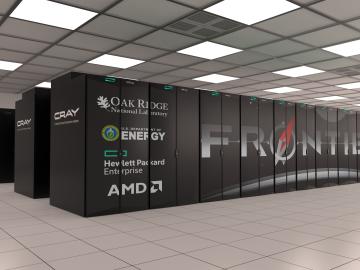Filter News
Area of Research
- (-) Supercomputing (39)
- Advanced Manufacturing (2)
- Biology and Environment (52)
- Biology and Soft Matter (1)
- Building Technologies (2)
- Clean Energy (49)
- Computational Biology (1)
- Computer Science (1)
- Electricity and Smart Grid (1)
- Functional Materials for Energy (2)
- Fusion and Fission (15)
- Isotopes (3)
- Materials (43)
- Materials for Computing (6)
- National Security (25)
- Neutron Science (14)
- Renewable Energy (1)
News Topics
- Artificial Intelligence (7)
- Big Data (3)
- Bioenergy (2)
- Biology (5)
- Biomedical (4)
- Buildings (3)
- Chemical Sciences (2)
- Climate Change (4)
- Computer Science (10)
- Coronavirus (3)
- Critical Materials (1)
- Cybersecurity (1)
- Decarbonization (2)
- Energy Storage (3)
- Environment (3)
- Exascale Computing (6)
- Frontier (7)
- Grid (2)
- High-Performance Computing (8)
- Machine Learning (5)
- Materials (8)
- Materials Science (5)
- Microscopy (2)
- Nanotechnology (3)
- National Security (3)
- Neutron Science (1)
- Partnerships (1)
- Physics (1)
- Quantum Computing (7)
- Quantum Science (4)
- Security (2)
- Simulation (5)
- Space Exploration (1)
- Summit (7)
- Sustainable Energy (2)
Media Contacts

Researchers at ORNL are teaching microscopes to drive discoveries with an intuitive algorithm, developed at the lab’s Center for Nanophase Materials Sciences, that could guide breakthroughs in new materials for energy technologies, sensing and computing.

ORNL researchers used the nation’s fastest supercomputer to map the molecular vibrations of an important but little-studied uranium compound produced during the nuclear fuel cycle for results that could lead to a cleaner, safer world.

A team of researchers has developed a novel, machine learning–based technique to explore and identify relationships among medical concepts using electronic health record data across multiple healthcare providers.

A study led by researchers at ORNL could help make materials design as customizable as point-and-click.

Tackling the climate crisis and achieving an equitable clean energy future are among the biggest challenges of our time.

Lawrence Berkeley National Laboratory physicists Christian Bauer, Marat Freytsis and Benjamin Nachman have leveraged an IBM Q quantum computer through the Oak Ridge Leadership Computing Facility’s Quantum Computing User Program to capture part of a

A force within the supercomputing community, Jack Dongarra developed software packages that became standard in the industry, allowing high-performance computers to become increasingly more powerful in recent decades.

Computational users at the Oak Ridge Leadership Computing Facility, or OLCF, are running scientific codes on Frontier’s architecture in the form of a powerful test system at the OLCF called Crusher.

A study by researchers at the ORNL takes a fresh look at what could become the first step toward a new generation of solar batteries.

Scientists’ increasing mastery of quantum mechanics is heralding a new age of innovation. Technologies that harness the power of nature’s most minute scale show enormous potential across the scientific spectrum




